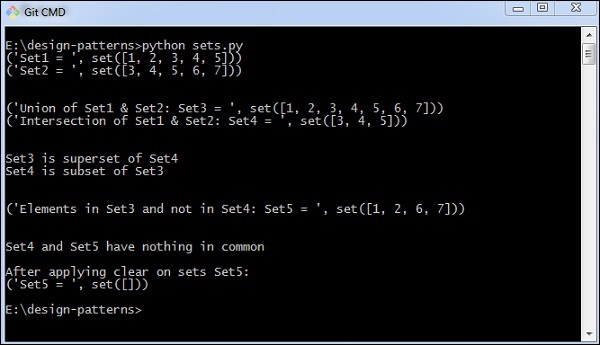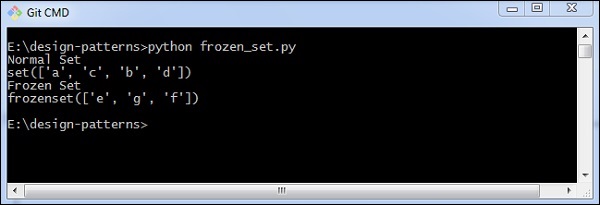Python Design Patterns Collections
Python Design Patterns: Collections
A collection can be defined as an unordered collection that is iterable, mutable, and contains no duplicate elements. In Python, the Set class is a notation for a mathematical set. The main advantage of using a collection is that it includes highly optimized methods for inspecting specific elements.
Python includes a separate category called frozensets. These collections are immutable objects that support only methods and operators that produce the desired results.
How to Implement Sets
The following program helps implement sets:
# Set in Python
# Creating two sets
set1 = set()
set2 = set()
# Adding elements to set1
for i in range(1, 6):
set1.add(i)
# Adding elements to set2
for i in range(3, 8):
set2.add(i)
print("Set1 = ", set1)
print("Set2 = ", set2)
print("n")
# Union of set1 and set2
set3 = set1 | set2# set1.union(set2)
print("Union of Set1 & Set2: Set3 = ", set3)
# Intersection of set1 and set2
set4 = set1 & set2# set1.intersection(set2)
print("Intersection of Set1 & Set2: Set4 = ", set4)
print("n")
# Checking relation between set3 and set4
if set3 > set4: # set3.issuperset(set4)
print("Set3 is superset of Set4")
elif set3 < set4: # set3.issubset(set4)
print("Set3 is subset of Set4")
else : # set3 == set4
print("Set3 is same as Set4")
# displaying relation between set4 and set3
if set4 < set3: # set4.issubset(set3)
print("Set4 is subset of Set3") print("n")
# Difference between set3 and set4
set5 = set3 - set4
print("Elements in Set3 and not in Set4: Set5 = ", set5)
print("n")
# Check if set4 and set5 are disjoint sets
if set4.isdisjoint(set5):
print("Set4 and Set5 have nothing in common")
# Removing all the values of set5
set5.clear()
print("After applying clear on sets Set5: ")
print("Set5 = ", set5)
Output
The above program produces the following output –

The following program can be used to demonstrate frozen sets of data:
normal_set = set(["a", "b", "c"])
# Adding an element to a normal set is fine
normal_set.add("d")
print("Normal Set")
print(normal_set)
# A frozen set
frozen_set = frozenset(["e", "f", "g"])
print("Frozen Set")
print(frozen_set)
Output
The above program produces the following output –
